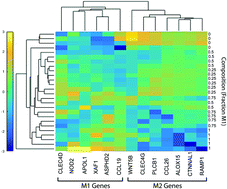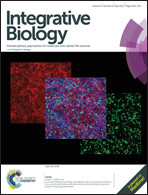Deconvolution of heterogeneous wound tissue samples into relative macrophage phenotype composition via models based on gene expression†
Abstract
Macrophages, the primary cell of the innate immune system, act on a spectrum of phenotypes that correspond to diverse functions. Dysregulation of macrophage phenotype is associated with many diseases. In particular, defective transition from pro-inflammatory (M1) to anti-inflammatory (M2) behavior has been implicated as a potential source of sustained inflammation that prevents healing of chronic wounds such as diabetic ulcers. In order to design effective treatments, an understanding of the relative presence of macrophage phenotypes during tissue repair is necessary. Inferring the relative phenotype composition is currently challenging due to the heterogeneous nature of the macrophages themselves and also of tissue samples. We propose here a method to deconvolute gene expression from heterogeneous tissue samples into the composition of two primary macrophage phenotypes (M1 and M2). Our final method uses gene expression signatures for each phenotype cultivated in vitro as input to a predictive model that infers sample composition with an average error of 0.16, and whose predictions fit known compositions prepared in vitro with an R2 value of 0.90. Finally, we apply this model to describe macrophage behavior in human diabetic ulcer healing using clinically isolated ulcer tissue samples. The model predicted that non-healing diabetic ulcers contained higher proportions of M1 macrophages compared to healing diabetic ulcers, in agreement with numerous studies that have implicated a dysfunctional M1-to-M2 transition in the impaired healing of diabetic ulcers. These results show proof of concept that the model holds utility in making predictions regarding macrophage behavior in heterogeneous samples, with potential application as a wound healing diagnostic.



 Please wait while we load your content...
Please wait while we load your content...